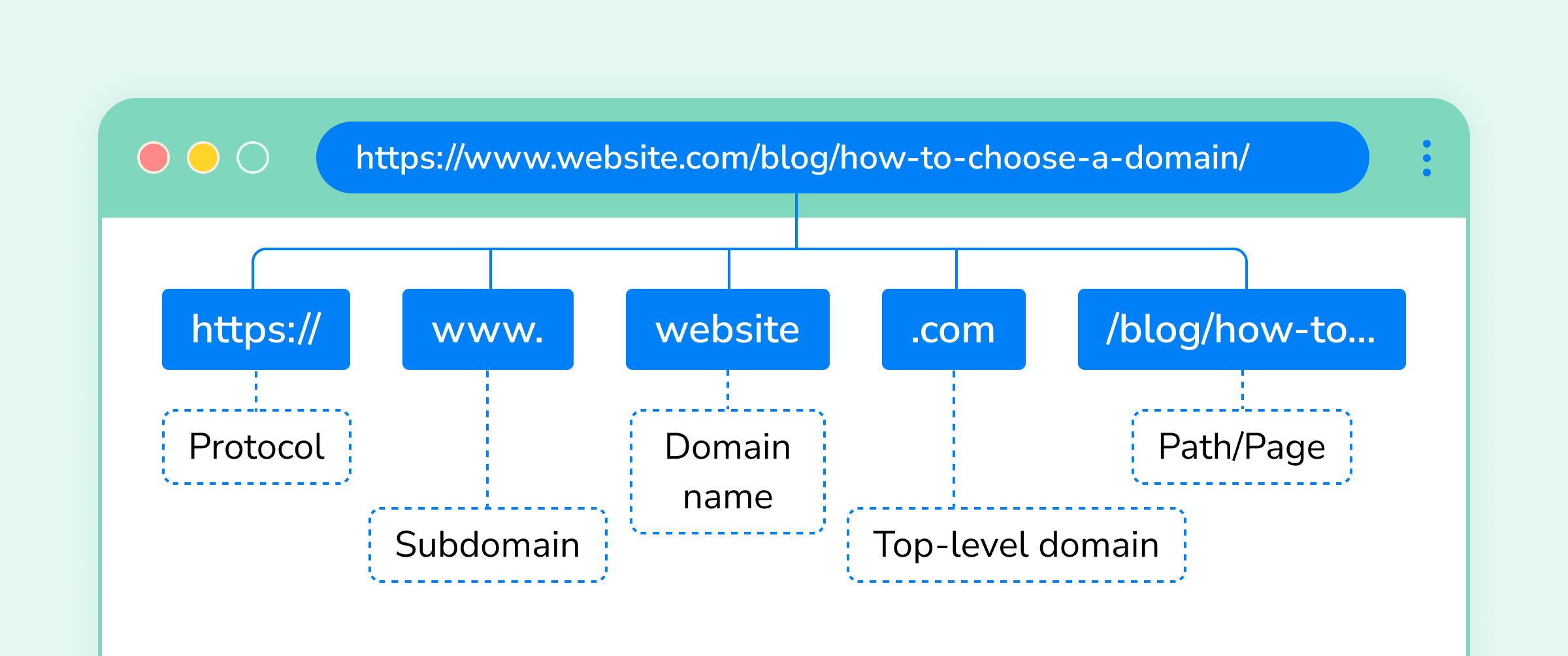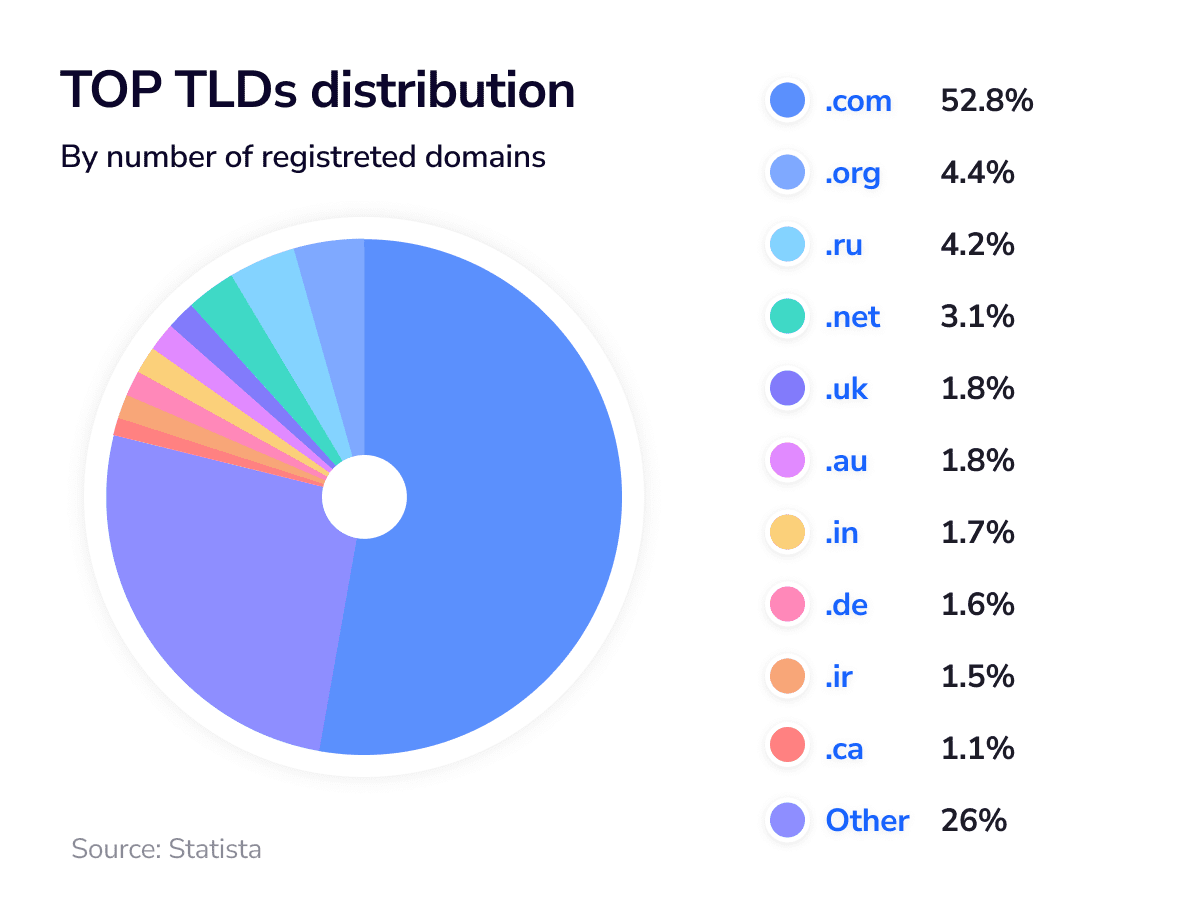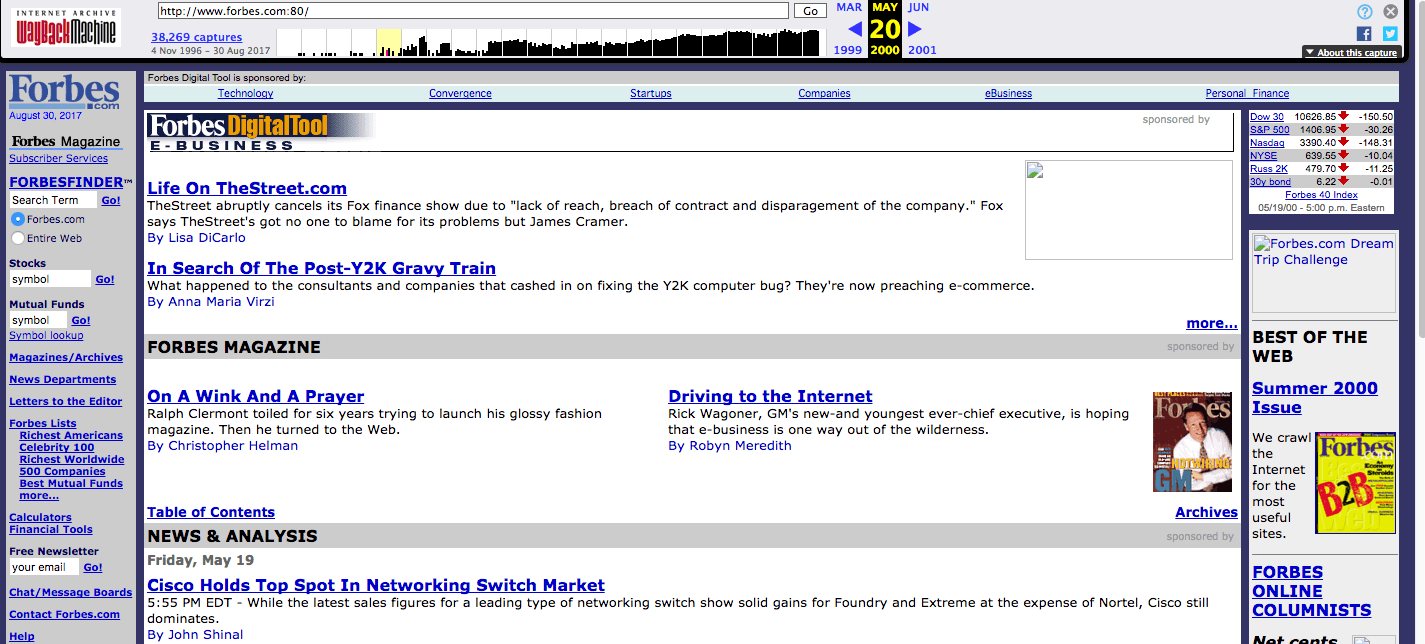How to Choose and Check a Domain for SEO
Buying a domain is like buying a car. It may look new and pretty at first glance, but it’s better to give it a thorough check and look under the hood before making the final decision. The same goes for domains—to boost their chances of having SEO success, multiple parameters must be checked up on like age, history, authority, and name.
In this article, we will analyze which domain parameters can indeed affect its future optimization, which ones won’t make a difference in terms of SEO, and which domain SEO techniques can come in handy.
Domain terms
Let’s start with the basics and learn domain terminology so we can all speak the same language.
A domain name (or domain) refers to a unique combination of characters and symbols that make up the site’s name. The user can type it into the browser window to go to the site with the same name. For example, if you want to visit the SE Ranking website, enter the domain name, seranking.com.
Domains typically consist of two main parts: a name (second-level domain) and an extension (top-level domain).
In the case of seranking.com, seranking is the name, and com is the extension or suffix. There are several types of extensions: generic, sponsored, or those that include a country code.
A domain can have a suffix and a prefix (also known as a third-level domain and a subdomain). Prefixes aren’t required, but using subdomains for SEO allows you to separate parts of your site’s pages, differentiate intents, and organize information more effectively.
The domain name is part of the website address, which is also known as the URL. The picture below shows you the general structure of the URL and where the domain name is located.

If you want to learn more about how to create an SEO-friendly website address check out our guide on building clean URLs!
Domain and SEO: how they are connected
The domain is the backbone of your website. The stronger it is, the higher your chances of conquering the SERP.
The strength of a domain is determined by three factors:
- History
- Backlink profile
- Name
Your domain’s history should be positive or at least neutral if you want it to function well after you begin using it. Search engines know of every domain’s past. If a domain has ever violated search engine principles, regaining their favor will be difficult.
A domain’s backlink profile is comprised of its backlinks. The quantity and quality of these links affect how well your site will rank. Many old toxic backlinks from unrelated sites can harm the optimization of your new site.
Of course, this only applies to already-used domains. If you buy a new domain name, it will have no history or backlinks. We’ll go over site history and backlink issues further in this article, so read it carefully.
The domain’s name is a vital part of your marketing strategy and promotion in the SERP. It should be SEO-friendly and reflect your brand and niche (more on this further in the article).
Once you’ve addressed all three aspects, you’ll have a better chance of having search engines fall in love with your domain. This, however, doesn’t guarantee you the top spot in the search results because there are other factors to consider (like content quality, page experience, internal links, etc.).
By the way, you can check any website’s SEO and see how well-optimized it is for both search engines and people using our SEO Website Checker tool.
What to choose: a new domain vs. a domain with a history
There’s no simple answer to choosing the right domain type because both new and old domains have unique characteristics.
A new domain is like a blank sheet of paper. It won’t disappoint you with any inherited filters or past penalties imposed by search engines. But you’ll also have to write your story on this blank ‘sheet of paper’ from scratch. This includes not only creating content but also optimizing for search engines and getting backlinks. All of this can lead to higher costs.
A previously used domain may have a positive history and high-quality backlinks which can boost your SEO. It would be even better if your site’s topic is the same or very close to that of the previous one. But what are the chances that you can find such a domain?
Another risk of buying a previously used domain name is that it is not always positive. The previous site owner might have used various black hat tactics, causing the site to fall under the filters of search engines. These shady practices include trading links, spam or illegal content, etc., and even exposing user data because of SSL/TLS certificate issues. You may therefore have to “pay for the sins” of the site’s previous owners and spend your time and resources restoring this domain’s reputation. So, before buying a domain for SEO purposes, research its history and how it may affect your SERP promotion.
As you can see, both paths have their pros and cons. But don’t get too caught up in the site’s age. Consider the experience behind it, as this is more important from an SEO perspective.
It’s not the domain’s age that matters but its experience
The domain’s age does not directly affect SEO. If that were the case, everyone would be purchasing pre-aged domains to manipulate the search results.
It all appears to be simple, but Matt Cutts, the former head of Google’s web spam team, said that there isn’t a noticeable difference between a six-month-old and a one-year-old domain. But could there be a sliver of difference that’s worth mentioning? Let’s find out.
We know for a fact that new websites practically never get top-ranking spots right after launch. Some SEO specialists call this phenomenon the Google Sandbox. It’s a filter that prevents newborn sites from ranking among the top results—it usually takes several weeks to months to get out of it.
Although Google claims there’s no such thing, experts tend to think that there are 3 reasons why new website rankings are delayed—they don’t have enough content, backlinks and user signals to rank high in the early days of creation. This is what we refer to as domain experience.
Long story short, there’s no point in striving to get a pre-aged domain in the hopes that you’ll get some sort of special attention from Google. There are two reasons why.
First, even if Google takes the domain age into account, it’s definitely not an important ranking factor. This means the site won’t occupy high SERP rankings because of its ripe old age. If you still want to understand how old a domain is, you can simple use our free Domain Age Checker tool.
Second, if a young site doesn’t have high rankings from the start, it’s due to a lack of relevant content, natural backlinks, and user signals.
So what are your options in this situation? If you’re not sure why your website isn’t ranking well, whether new or old, it’s always a good idea to use an online rank tracker to track the positions and analyze possible causes. This allows you to monitor your domain’s performance in the SERPs, compare your ranking to that of your competitors, and pinpoint the source of the problem. Once you understand the root cause of your low ranking (for example, a poor domain experience), you can devise an appropriate solution.
Domain name for SEO: does it matter?
Yes, but it isn’t considered a direct Google ranking factor. Still, whatever you name your boat, that’s how it will float.
Certain domain name elements are critical to your overall SEO success. These are:
- Memorability. If your domain name is easy to remember, the user can type it in the search and immediately go to your site. This increases direct traffic.
- Length. Shorter names are easier to read and remember, while longer domain names can be more descriptive and convey your purpose better. Because there is no one-size-fits-all solution here, you must tailor it to your needs and goals.
- Keywords. Inserting your keywords into the domain name is no longer an SEO must. But it can help you describe your business better.
- Branding. When a domain name reflects your company, this builds trust and authority, and it positively affects user behavior. Users are also more likely to click on a website with a strong online brand behind it.
The bottom line is that search engines know which sites users like and promote them in search results. A domain name is only one of the first things a user sees when they visit your site, so make it user-friendly, SEO-friendly, and brand-friendly.
5 things you should look at to optimize your domain name
Let’s explore some domain SEO considerations you should be aware of. These include: what to consider when choosing a domain, how to correctly evaluate domains “with history,” and what advice should be given to those who rack their brains around choosing from various keyword-packed domains.
1. Domain zones and levels are up to you
According to the latest statistics, about 52.8% of all domain names use the .com extension. Considering its popularity, it might be the most trustworthy domain zone for your future users. At the same time, such a high demand means that all of the best names in this zone are already taken. If you’re unable to register your domain in this zone, consider .net, .org, .co, .biz or one of the new top-level domains.

Remember, however, that even some top-level domains may not have the best background. For example, the domain extensions .xyz, .ws, .name, etc., are associated with spam.
Domain zones and levels play an important role when you’re dealing with a specific country. Google tends to prioritize regional domains such as .uk, .fr, .fi, etc., in the regions to which they belong. Moreover, people used to give more credit to regional domains because they are more familiar and clear to them.
Country-level domains, however, fall into the so-called restricted group. In some countries, such as the UK, Canada, Australia, China, Japan, etc., you may be required to provide additional documents and go through extra steps to get a country code in your domain name. The same can apply to some cities. For instance, those who want to use the .nyc extension in their site name must have a valid address in New York.
Also, some domain zones can have additional meaning through the combination of their letters. These regional zones include .tv (Tuvalu) or .fm (the Federated States of Micronesia). If your site is selling yoga video courses, for instance, yoga.tv could be a nice option.
New top-level domain zones like .money can give your site creative branding opportunities and yield good SEO results. In 2015, Google announced its own domain registrar Google Domains. In this service, you can register new top-level domains (TLD) such as .boutique, .catering, .coach, .florist, .coffee, .jewelry, .photography, .systems, etc.
Note that Google treats new top-level domains like other general domains (.com & .org) — without any additional preferences or a special ranking attitude. But having a new TLD helps you stand out in the network by defining your niche.
It’s also a great chance to deliver your message if you make a phrase out of it. This could be in the form of danis.cool, annlikes.to, iknow.how, lets.talk, and so on. If you are confident that this kind of domain will succeed in your niche, consider purchasing it.
You might have heard of possible SEO boosts for zones like .edu, .gov, but know that they can not be bought off-the-cuff and should only be used for their intended purposes—education, governmental or military needs respectively. To get a .edu domain extension, for instance, you must prove that you run an accredited educational institution.
Imagine a footwear store with a .gov domain zone. Sounds silly, right? That’s why search engines hold these domains in such high esteem. You can’t just buy them, and they have specific requirements and standards you must maintain.
There are also industry-restricted domain extensions that are only available to companies operating in a specific industry. Only members of the civil aviation community, airline companies, airports, government agencies, and qualified individuals associated with the air transportation industry can use .aero in their domain name. The same applies to .mil, which is a US military extension that can only be used by US military services.
In a nutshell, Google doesn’t claim that the domain zone has a direct impact on rankings. If you plan on competing in the global market, you must register a top-level domain and take your niche (.com, .net, .org, .biz) into account when you do it.
To successfully promote a site in a certain country, we recommend registering a domain in the same country. The search giant tends to display “.fr” pages to users in France, and “.uk” pages in the UK. But don’t forget to provide the site with the properly configured language versions (if any).
2. Names should tell stories
There are some important naming rules to consider before purchasing a domain.
For one, its name should be easy to remember and spell. Keep your SEO domain name simple by minimizing the character and number count. Avoid complicating the name entry process for users and creating additional opportunities for human errors.
Pay special attention to domain names with hyphens (dashes). Domain names without them are more convenient for the user because they can forget to include a hyphen and end up on the wrong site. For example, seranking.com and se-ranking.com are two completely different sites.
It may also be difficult for you to rank with a domain name that’s associated with something other than your brand. Let’s say you own Aphrodite, a beauty product marketplace, and you use this term in your domain name. In this case, expect Wikipedia pages, dictionaries, and other online encyclopedias to outrank you in search results.
Also, try not to exceed the 15-character name length. Shorter is always better.
Regarding the use of non-English symbols (cyrillic, hieroglyphs) in the domain name, John Mueller from Google said in a recent video that using non-English URLs for non-English websites is fine. He further explained that Google is able to crawl, index, and rank them.
Here are a few more tips on domain naming:
- Domain names should be easily written, not have a double meaning, and be associated with your business’s specific industry.
- Do not use copyrighted words or phrases in domain names. Before registering a domain, check it through free services such as http://www.copyright.gov/records and http://www.uspto.gov/trademarks.
- You can use the domain name generators available online. They allow you to easily mix and match keywords, add prefixes/suffixes, and, at the same time, immediately check which domains are still available. After you have a list of 3-5 domain ideas, poll your colleagues/friends to determine which one is the most appealing.
And last but not least, think about whether you want to use the www vs. non-www prefix. It’s up to you, but if you plan to use both options, don’t forget to tell search engines which version you prefer.
3. Keywords are not always key
A domain name that precisely matches a search query is called an exact match domain (EMD). For example, if you want your site to rank for the keyword “best seo tool”, the EMD would be bestseotool.com. Accordingly, a partial match domain name (PMD) contains both the brand name and one of the targeted keywords.
So if you’re trying to rank for the keyword “Chicago pizza”, any domain with “pizza” or “Chicago” in it would be a partial match domain. For example—“andrewpizza.com” or “chicagofood.com”.
But what’s better for SEO? Let’s dig a little deeper.
EMD and PMD pros:
- Users understand what to expect from the site by looking at the domain name
- Higher CTR
- Can get long-tail traffic and mentions with keywords
EMD and PMD cons:
- EMDs can be classified as spam
- Over-optimization of the anchor list
- In some cases, they are difficult or very expensive to get (register/purchase)
- May hamper brand development
In October 2012, Google introduced a new EMD filter that ensures that low-quality domains don’t climb to the top of Google’s SERPs merely by including the search terms in their names. The .com domain is less likely to fall under the Google EMD filter because search engines trust them more compared to others.
If you have high-quality content on your site, won’t just apply the filter because it’s an EMD. Also, Google representatives told us loud and clear that keywords in the domain name don’t provide any additional preferences in the search results.
Make the decision based on your goals.
If you’re going to develop a brand, it’s better to use its name in the domain. If you don’t do it, someone else will take it and use it for their own purposes. Ignoring the brand name and focusing on the keywords could play a low-down trick on you. Your brand won’t get a mention without a link, and if you decide to expand the website product lines, your domain name may no longer correspond with its specifics. Moreover, people tend to remember brand names more easily than names with general keywords.
4. Domain history is the skeleton in your closet
If you decide to buy a previously used domain, researching its history will help you discover important facets of its content at different points in time. Why should the domain’s past bother you? Because if you don’t know what you’re dealing with, it can negatively impact your site’s karma.
Imagine that you want to buy a domain with history/trust/recognition. Or, if you’re looking for a domain for a new brand, it’s possible that this domain name was previously occupied by someone else, in which case you should know how relevant it was to your niche.
Check up on the domain’s history before completing your purchase to minimize your chances of being surprised by any adult or forbidden content that it could have had in the past.
Go to http://web.archive.org/ and enter the domain name you’re interested in. You will then see what it looked like at a previous time.

It’s also worth checking the previous hosting provider (owner) and how often it was changed. This will help you figure out how stable the site was and how many hands it passed through over the years.
When it comes to researching domain history, it isn’t superfluous to go the extra mile. To make sure the domain you want to use is “safe” and trustworthy, check the following items:
- Keywords the domain previously ranked for. This will help you understand the niche this domain once targeted and whether it suits you. Use the previously mentioned online rank-tracking tools to make this task more convenient and quick.
- Domain pages in the index. Detect the pages indexed not only by Google but also by other search engines like Bing or Yahoo. Enter site:yourdomain.com. This way, you can see pages that were indexed and ranked by Google and find traces of low-quality pages.
- Domain backlinks. Analyze the ratio of strong versus spam backlinks to get a feel for how healthy this domain’s backlink profile is and whether any black-hat SEO practices were used.
- Top pages that get the most backlinks. You can find any irrelevant pages on your site that are mistakenly getting the lion’s share of backlinks from other sites.
- Anchor texts. You’ll see what texts were used in the links (if any) and whether the keywords in these texts were related to the domain’s niche in the past. This will allow you to see if any anchor text manipulations were used to influence rankings.
These checks can take a lot of time and resources, but they’re necessary if you don’t want your SEO efforts to be in vain. You can use SE Ranking’s Сompetitive Research, Backlink Checker, and Site Audit Tool to make this task easier. They’ll make domain history analysis a piece of cake and equip you with valuable insights to make data-driven decisions.
If you are considering purchasing a previously used domain, it’s essential to research the optimization techniques implemented by the former owners. You can use our website audit template, which outlines all the necessary steps for conducting a quality check.
Finally, check the domain history for as many different dates as possible because you never know what skeletons you’ll find.
5. Authority may be contradictory
Domain authority isn’t a ranking factor, but you should still evaluate a domain’s credibility if someone else used it before you.
SE Ranking has designed DT (Domain Trust) and PT (Page Trust) parameters for this purpose. Each assesses domain and page quality based on multiple factors, including the number and quality of a website’s referring domains and backlinks. You can check your domain authority with the help of the Competitive Research and Backlink Checker tools.

However, don’t be misled: Google does not use any domain authority metrics calculated by third-party tools. They have their own algorithm, but they don’t disclose any details about how it works.
If you decide to buy a previously used domain, checking its domain and page trust can help you hedge your bets. But you shouldn’t solely rely on authority metrics because there are many other characteristics to consider.
Now it’s your turn
Getting the name right is half the battle.
Now that you know what to look out for in a domain name before buying it, it’s time to take action!
If you’ve already landed the perfect domain name, please share it with us! Was it a hard choice? What were your guiding principles for choosing it? What domain SEO techniques did you use? Would you change it now that you’ve read this blog post?
The SE Ranking team is looking forward to hearing your story 🙂

